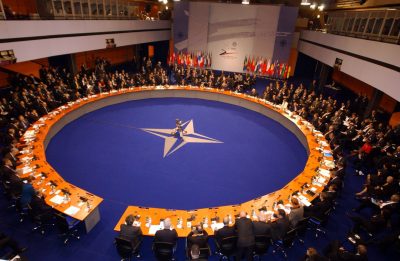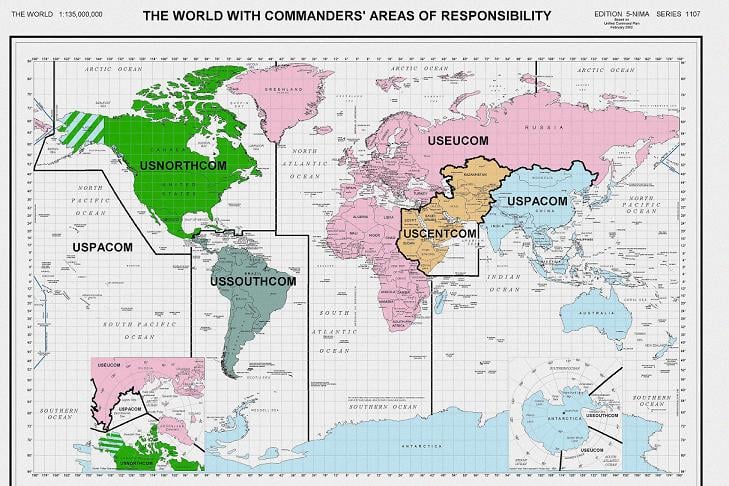The US/NATO Planetary War System
The 70 Years of NATO: From War to War

The Following text is Section 15 of 16
The 70 Years of NATO: From War to War,
by the Italian Committee No War No NATO
*
Documentation presented at the International Conference on the 70th Anniversary of NATO, Florence, April 7, 2019
In the course of the next two weeks, Global Research will publish the 16 sections of this important document, which will also be available as an E-book.
*
Contents
1. NATO is born from the Bomb
2. In the post-Cold War, NATO is renewed
3. NATO demolishes the Yugoslav state
4. NATO expands eastward to Russia
5. US and NATO attack Afghanistan and Iraq
6. NATO demolishes the Libyan state
7. The US/NATO war to demolish Syria
8. Israel and the Emirates in NATO
9. The US/NATO orchestration of the coup in Ukraine
10. US/NATO escalation in Europe
11. Italy, the aircraft carrier on the war front
12. US and NATO reject the UN treaty and deploy new nuclear weapons in Europe
13. US and NATO sink the INF Treaty
14. The Western American Empire plays the war card
15. The US/NATO planetary war system
16. Exiting the war system of NATO
***
1. In the “geography” of the Pentagon, the world is divided into “areas of responsibility”, each entrusted to one of the United States Unified Combatant Command: the Northern Command covers North America; the Southern Command, Central and South America; the European Command, the region comprising Europe and the whole of Russia; the African Command, the African continent (except Egypt which falls within the Central Command area); the Central Command, the Middle East and Central Asia; the Pacific Command, the Asia/Pacific region.
2. Each unified command is composed of the commands of the different components of the US Armed Forces in that area. For example, the US European Command consists of: US Army in Europe, US Air Forces in Europe, US Naval Forces in Europe, US Marine Forces in Europe and US Special Operations Command in Europe. The command of each force is in turn articulated in a series of sub-commands and units. For example, the US Army in Europe has 22 sub-commands and units.
3. To the six geographical commands, three are added on a global scale: the Strategic Command, responsible for the terrestrial, air and naval nuclear forces, the military operations in space and cyberspace, the global attack, electronic warfare and missile defense; the Special Operations Command, with a specific command in each of the six areas plus one in Korea, responsible for non-conventional warfare, counter-insurgency operations, psychological operations and any other mission ordered by the President or Secretary of Defense; the Transport Command, responsible for the mobility of soldiers and armaments by land, air and sea worldwide.
4. The United States of America is the only country to have a military presence on a global scale in every continent and region of the world. The Pentagon is the direct owner of over 4,800 bases and other military installations, both domestically and abroad, including over 560,000 buildings and structures (such as railways, oil pipelines and airport runways). According to official Pentagon data, the United States has around 800 bases and other military installations in over 70 countries, especially around Russia and China, plus many others in use or classified. These bases are used for a continuous rotation of forces, which rapidly increase together with those transferred from the bases in the United States in certain war theaters. There are more than 170 countries where US troops are deployed, including those where the U.S. has no military bases. In terms of comparison, Russia has only a dozen military bases abroad in the former Soviet republics and in Syria; China has one in Djibouti, where its military and civilian ships call.
5. In the wake of the United States’ moves, NATO, the alliance under US command, now has no more borders. In Europe – after having extended into the area of the former Warsaw Pact, the former USSR and the former Yugoslavia – it is actually incorporating Ukraine. In Central Asia, NATO is incorporating Georgia, which already integrated in its operations. It is a candidate to become a full member of the Alliance. NATO also continues to “deepen cooperation” with Kazakhstan, Kyrgyzstan, Tajikistan, Turkmenistan and Uzbekistan, to counter the Eurasian Economic Union (which includes Russia, Belarus, Kazakhstan, Armenia and Kyrgyzstan). It also remains engaged in Afghanistan – a country of great geostrategic importance to Russia and China.
6. In Western Asia, NATO continues military operations against Syria and is preparing others (Iran is still in the crosshairs). At the same time, it is strengthening its partnership (tested in the war against Libya) with four Gulf monarchies – Bahrain, United Arab Emirates, Kuwait and Qatar – and military cooperation with Saudi Arabia that is killing Yemen with cluster bombs provided by the US. In East Asia, NATO has concluded with Japan a strategic agreement that “broadens and deepens the long partnership”, which is joined by a similar agreement with Australia, with an anti-Chinese and anti-Russian function. For the same purpose, the major NATO countries (including Italy) participate every two years in the Pacific in what the US Fleet command calls “the greatest maritime exercise in the world”.
7. In Africa, after destroying Libya, NATO is enhancing military assistance to the African Union, which it also provides “naval planning and transportation” in the strategic framework of the United States Africa Command. In Latin America, NATO has signed a “Security Agreement” with Colombia, which has already engaged in Alliance military programs (including the formation of special forces) and has become “NATO’s first partner in Latin America”. NATO, therefore, now has its hands on a subversive plan against the Bolivarian Republic of Venezuela.
*
Section 16 of the 70 Years of NATO, From War to War, forthcoming on Global Research
This text was translated from the Italian document which was distributed to participants at the April 7 Conference. It does not include sources and references.
Note to readers: please click the share buttons below. Forward this article to your email lists. Crosspost on your blog site, internet forums. etc.


